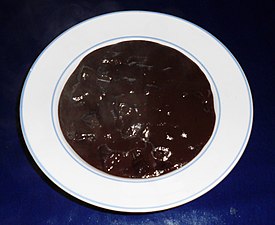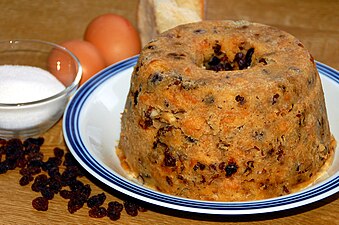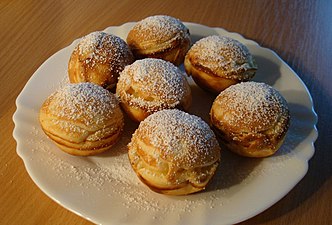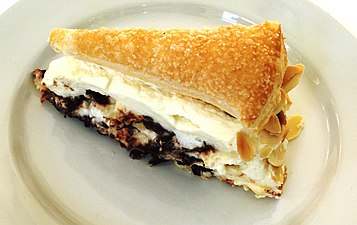The traditional cuisine in Schleswig-Holstein is rooted in land and seas. There is a special taste that the North German Broken Sweetness, Brooken Soot, is called. This is reflected in the popular sweet and sour flavor combination, söötsuur, in the combination of spicy meat or fish dishes with sweet side dishes. Typical dishes are pears, beans and bacon, or Holstein sour meat.
dishes
- Labskaus. is the traditional dish of seafarers. It consists of salted meat, potatoes, onions, herring, beetroot and cucumber. The ingredients are turned by the wolf and served with cucumber and fried egg. The Labskaus is designed in very different versions, and individual ingredients are often served separately.
- Pears, beans and bacon are cooked together and then served with boiled potatoes. The taste of the sweet fruit and the spicy, hearty bacon result in the typical broken sweetness.
Labskaus with fried egg, beetroot and rollmops

Pears, beans and bacon
- Black and sour, Swattsuer, fresh pork blood coagulates with the addition of vinegar, then it is boiled with meat and spices cut into goulash-sized cubes. Potatoes or semolina dumplings are served with it.

Black and sour
Side dishes
- Kale is a typical winter vegetable. In many parts of Lower Saxony and Schleswig-Holstein, it is a real cult to go on a cabbage ride with clubs, companies and other groups in the autumn and winter months. A typical dish is cabbage with Pee, a smoked grützwurst.

Kale with boiled sausage, pork cheek, smoked pork and sweet (slightly caramelized) fried potatoes

Kale with pee, boiled sausage, smoked pork and bacon

Kale with pee
- Flour bag, Meelbüdel, is a dumpling with eggs that is wrapped in a linen cloth, the bag, and then cooked in water. The dumpling is served with sugar, liquid butter and slices of pork cheek meat.
- A big Hans, Groot Hans, can be served sweet or with savory side dishes, warm or cold, as a main course or as a dessert. It is prepared either with a flour / yeast dough, or with a dough made from semolina, milk and eggs. The mass is brought to a standstill in a fall form in a water bath. It is served with Kasseler, Mettenden or pork cheek and compote, hot cherries or sometimes with jam. For dessert you just leave out the meat side dishes. The next day, its cold leftovers are often fried in butter.

Dithmarscher flour bag with left bacon and cherries

Big Hans with raisins
Soups
- Schnüsch is a vegetable soup with potatoes, beans, peas, kohlrabi, carrots and milk or cream. Smoked ham and herring are served on a second plate as a side dish.
- Lilacberry Soup is made in winter from elderberry juice, sago and apple pieces and seasoned with sugar and rum. Flour or semolina dumplings are served with it.
- Buttermilk soup used to be a "poor people" food, today it is eaten as a starter. Buttermilk and milk are boiled, thickened with pudding powder and seasoned with sugar. As a filler, there are prunes, or toasted black bread or chopped raisins.
Lilacberry Soup
fish
It will come as no surprise that seafood is the dominant culinary element on the coast.
- Kiel sprats are a fish specialty from Schleswig-Holstein. Sprats, a herring-like sea fish, around 10 cm long are used, which are smoked over beech and alder wood. Some eat them whole, without exception, head and tail. Usually, however, the head is cut off before eating and the tail with the main bone is carefully pulled out.
- A real Heligoland The specialty is "Helgoland Knieper". These are the claws of the edible crabs found around the island. They are served hot and usually as a kilogram portion. There is also baguette or toast, butter and several sauces. In some restaurants you have to break open the scissors yourself to get to the meat. There is a special knee cutlery for this.
- In Glückstadt is the local specialty Matjes, which is made in traditional handicraft. Today there are still two local producers who process the herrings according to traditional recipes.
Kiel sprats
A plate full of knees

Glückstadt Matjes
- Panfish consists of fried or cooked pieces of fish, fried potatoes and mustard sauce. Often in restaurants a vegetable side dish or a salad is served with it.
.jpg/335px-Pannfisch_Roter_Hof_Flensburg_(retuschiert).jpg)
Pan fish with vegetables
Pastries
- Wort are made from yeast dough and fried in fat in a special pan. They are available with or without filling. Popular fillings are apple or plum jam, pitted prunes or apple pieces. Chopped almonds or raisins are used for refinement. They are especially baked at Christmas and New Year's Eve.

Fartlet pan

Wort
- Ice cream cake is a layered cake. On a shortcrust pastry base, plum jam, whipped cream and bases made of puff pastry are layered alternately, after two to three layers a layer of cream forms the end. A triangular piece of puff pastry is then placed at an angle for each piece of cake.
A piece of Frisian cake
Sweets
- Lübecker marzipan is a protected geographical designation of origin for marzipan Lübeck, Bad Schwartau and Stockelsdorf. It must contain at least 70% marzipan raw mass and a maximum of 30% sugar.

Lübeck marzipan comes in many forms
ingredients
- Dithmarschen is for growing Cabbage known. During the harvest season, the Dithmarscher Kohltage hosted.
- Holstein ham, juicy ham is cured with salt and spices for 4 weeks and then cold-smoked with large quantities of beech smoke at 25 ° C.
- Holstein sour meat is usually stored in a glass and is therefore durable for a long time. Lean pork is cooked in vinegar with spices. The cooked meat is cut into portions and put back into the cooking stock in a glass. After cooling, the broth made from vinegar and fat gels and takes on a firm, jelly-like consistency. In the glass, the acid in the vinegar breaks down the connective tissue and the meat, making the meat particularly tender and tender. Holstein sour meat is often eaten with tartar sauce, pickles, butter and bread.

Holstein ham

Holstein sour meat
beverages
- Pharisee consists of coffee with rum and cream
- The Dead aunt is made from hot chocolate, rum and cream
- Angler Muck is an alcoholic drink similar to grog. It consists of rum, water, sugar and is seasoned with a little lemon juice. Traditionally it is served in an "Angler-Muck-Pott" on a warmer and drunk from special small glasses. It is also served cold, with lemonade and grain, or with rum and lemon froth.
- A Seagull shit consists of a glass with 4 cl double grain, on top of which lies a slice of salami with a dollop of mustard and horseradish. First the salami is plastered with the topping, then rinsed with the grain.

A muckpot
beer
Will be happy Lütt un Lütt (Small and small) ordered a small beer and a schnapps.
- The Flensburger Pilsener, which is colloquially known as Flens is probably the best-known type of beer in Schleswig-Holstein.
- In second place is the Dithmarscher Pilsener from Marne in the district Dithmarschen
Wine
- 1 Ingenhof fruit and wine estate, Dorfstrasse 19 23714 Bad Malente - Malkwitz. Tel.: 49 4523 202159. Wine is grown on a south-facing slope with a 35 ° incline. There are vineyard tours and you can taste and buy the wine.
Schnapps and liqueurs
- rum has in Flensburg a long tradition. In the 18th century, the city was a major trading port for ships in the West Indian Fleet. They brought the strong raw rum from the Caribbean to Germany.
- Com is a light yellow, gold-colored aquavit with 32% - 35% vol. It is usually drunk cold. It is used warm in tea punch or punch punch, often in proper style in blue and white teapots and tea cups.
- As Klötenköm (Klütenkööm) is the name of the egg liqueur
Soft drinks
Culinary calendar
Culinary delights are often seasonal. Fruits and vegetables are tastier when they are ripe; meat and fish are also subject to seasonal influences. Every season of the year, festivals are celebrated that have a general theme or focus on certain foods. There are also drinking and eating habits throughout the year that arose from religious traditions such as fasting times.
January
- Schleswig-Holstein Gourmet Festival
February
- Schleswig-Holstein Gourmet Festival
March
- Schleswig-Holstein Gourmet Festival
April
- The Asparagus season starts at the beginning of April, depending on the soil temperature
- Traditionally on April 23rd the Day of the beer celebrated, because on this day in 1516 the German purity law was proclaimed. There are events on the topic of beer in many places (German Brewers Association).
May
- Asparagus season
- In the third week, starting on Thursday, the North FrisianLamb days, with specialties from the salt meadow lamb
June
- The Asparagus season ends on Midsummer Day, June 24th.
- The Herring days in Kappeln - always 4 days after Ascension - offer not only a lot of hustle and bustle but also a lot of culinary specialties.
- On the first or second Sunday in Lübeck-Travemünde the Travemuender cake festival celebrated. 200 different fruit and cream cakes are offered in the Brügmanngarten
- On the 2nd Thursday in June they celebrate Glückstadt the Matjes weeks. The heavy wooden barrel is opened on the historic market square and there are various events for 4 days.
- For the last full week, the Kiel Week held on the Kiel Fjord. On the Rathausmarkt in Kiel More than 30 nations serve their specialties.
July
August
September
- The Dithmarscher Kohltage take place in the second half of September
- From September to March this will be across the country Schleswig-Holstein Gourmet Festival held. Germany's best chefs show their skills in around 20 different restaurants. There are specialties from the sea, game meat, dike lamb and more.
October
- On the second weekend in Husum the Husum Crab Days held, you can buy crabs directly from the cutter. Crab pulp competitions, market stalls and music provide entertainment.
- Schleswig-Holstein Gourmet Festival
November
- Schleswig-Holstein Gourmet Festival
December
- Schleswig-Holstein Gourmet Festival
- There is always something culinary to discover at the Christmas markets
literature
Recipes
If you want to enjoy Schleswig-Holstein cuisine at home, you will find the appropriate recipes in Koch Wiki under Category: Schleswig-Holstein cuisine. Have fun cooking at home.














.jpg/335px-Pannfisch_Roter_Hof_Flensburg_(retuschiert).jpg)







